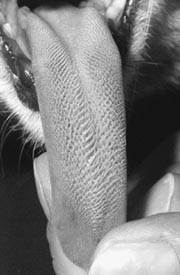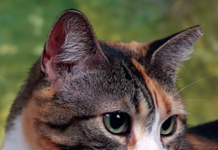Mother Nature equips every cat with an anatomical Swiss Army knife.
Powerful and extremely durable, used for eating and grooming, this tool is the very same tongue that lavishes you with affection. It is easy to underestimate how important the cats tongue is to her good health and happiness.

180
Detect taste, texture
James Richards, DVM, director of the Cornell Feline Health Center, describes the cats tongue as carpeted with sharp, backward-pointing, bristle-like projections called papillae. Used to lick meat from bones, remove feathers from birds, and as a grooming tool, these papillae are the source of what we humans call the cats sandpaper tongue.
Along with the ability to detect taste, which comes from tiny taste buds located on other non-bristle-like papillae, the cats tongue is also capable of perceiving texture and temperature. These three things – taste, temperature, and texture – are central to your cats preferences in food and water. When cats drink, their muscular tongue curls backward almost like a spoon or dipper, and with each lick, water is propelled (flipped) to the back of the tongue.
The ultimate grooming tool
Imagine what your cat would look like if she did not groom herself on a regular basis! Once again, the tongue comes through, this time as the ultimate grooming tool. The sharp papillae, aided by moisture supplied by saliva, loosen and pick up dirt and hair shed from the coat. When your cat grooms herself, natural oils are spread over her skin, keeping it from becoming dry and flaky, according to William Miller, VMD, professor of dermatology at the Cornell University College of Veterinary Medicine.
Although some cats are not quite as fastidious about grooming as others, a cat that seems to be grooming herself less or ceases to groom altogether may be sick and should be taken to your veterinarian as soon as possible. Excessive grooming can also be problematic and may indicate a skin or behavioral problem.
Miller, who is board certified by the American College of Veterinary Der-matology, states that people who are allergic to cats are sensitive to an allergen in cat saliva, which is deposited by the tongue on the hair during grooming. Bathing the cat, an exciting experience for both you and her, removes the allergen only temporarily.
Injuries can happen
Injuries can and do occur to the cats tongue. Lacerations, chemical and electrical burns, foreign-body penetration (fish hooks are common), and foreign-body strangulation can cause injury to the tongue, says Abraham Bezuidenhout, DVSc, senior lecturer in biomedical sciences at the Cornell University College of Veterinary Medicine. The very papillae that aide in eating and grooming can catch and hold pieces of string or yarn and make it impossible for the cat to dislodge them.
If your cat is drooling excessively, stops eating and/or grooming, or rubs her face
frequently, you should check to see if there are any obvious problems associated with the tongue or mouth. You may find this hard to do yourself, and a trip to your
veterinarian may be in order for a thorough evaluation.
It is easy to overlook the many important functions that the cats tongue performs, but a healthy tongue is imperative for the overall physical and emotional well being of your cat.



